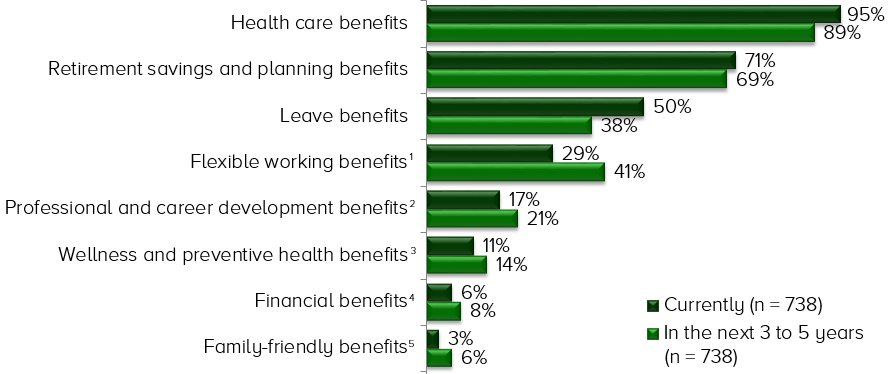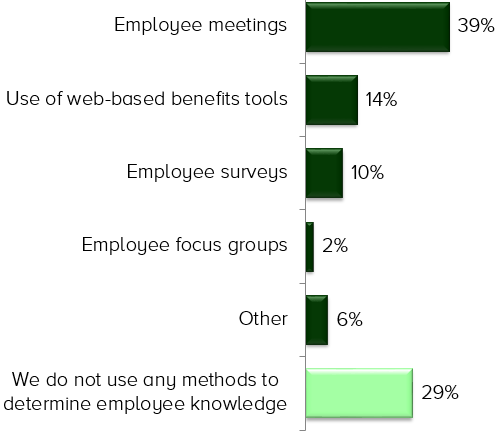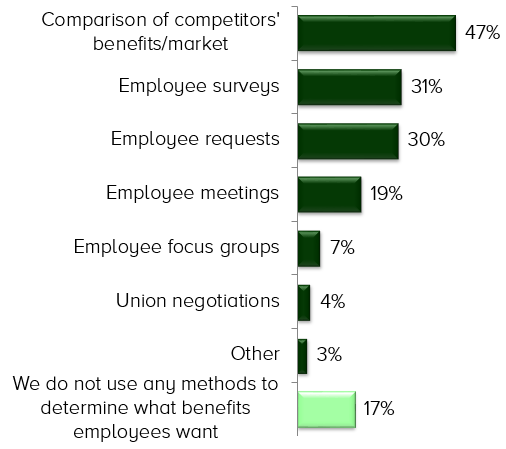Employers Alter Benefits to Attract, Retain Employees, SHRM Finds
Explaining the value of the benefits mix also keeps talent onboard

As hiring and keeping talented employees becomes more difficult, HR professionals are strategically leveraging employee benefits as a recruitment and retention tool, according to 2016 Strategic Benefits survey findings released by the Society for Human Resource Management (SHRM) on Nov. 30.
From a randomly selected sample of SHRM members, 738 HR professionals participated in this year's survey, which was conducted in April and May. Analyses of the results are posted online in five separate reports.
| The Benefits Most Important to Employees Respondents said the following were the benefits most important to a majority of their employees: |
  |
| Source: Society for Human Resource Management, 2016 Strategic Benefits Survey—Assessment and Communication of Benefits. |
Retaining Employees
A tighter job market requires that an organization present itself as an employer of choice, a situation that is leading HR to offer benefit options that appeal to a wide range of employee demographics, the 2016 Strategic Benefits—Leveraging Benefits to Retain and Recruit Employees report found.
"Organizations that have already started to alter their benefits to aid in retention may have a strategic advantage," said Karen Wessels, researcher for workforce planning at SHRM. "As early adopters of new benefits, or by finding innovative ways to leverage their existing benefits, organizations that are acting now may be able to reaffirm a positive employer brand before competition for talent gets even more intense."
The survey revealed that:
- Nearly one-fifth of HR professionals altered their benefits program to aid in the retention of employees over the past 12 months. Of these organizations, about three-fifths altered their health care benefits; more than one-third altered their flexible working, retirement savings and planning, leave, and professional and career development benefits as well.
- About three-fifths of respondents indicated that benefits for professional and career development, flexible work, health care, and retirement savings and planning will increase in importance to retain employees in the next three to five years. More than one-half expect that wellness and preventive health benefits will increase in importance to retain employees over the same period.
The 2016 Strategic Benefits—Wellness Initiatives report further showed that about two-thirds of organizations offered some type of wellness program, resource or service to their employees, and that:
- Almost one-half of HR professionals at these organizations said that wellness initiatives decreased their health care costs.
- About two-fifths said that wellness initiatives decreased unplanned absences.
- About one-third said wellness initiatives increased work productivity.
"Organizations are most likely to alter the benefits employees value most highly to meet the needs of a changing workforce," Wessels said. "Health care, retirement and leave benefits are all highly valued by employees, so enhancements to them could go a long way in helping to improve an employer's value proposition."
In addition, flexible work practices (for example, telecommuting, remote working and flexible hours) "can often be leveraged with little to no additional costs and are therefore also a good option for HR to look to [in order to] boost talent retention," she said.
Over one-half of HR professionals' organizations provide employees with the option to use flexible work arrangements, according to the 2016 Strategic Benefits—Flexible Work Arrangements report. Among those organizations, about one-half indicated that the majority of their employees had access to these benefits, although that finding was skewed toward high-tech companies (64 percent) in contrast with other industries (41 percent).
[SHRM members-only toolkit: Managing for Employee Retention]
Generational Differences
Successful organizations also tailor their benefit offerings based on employee demographics such as age and education levels. As the workforce ages, for instance, retirement savings and planning benefits may become more important to a larger cohort of employees.
At the same time, Millennials and their younger Centennial/Generation Z counterparts face unique generational challenges, such as high levels of student debt and more-difficult financial circumstances, Wessels noted. Their comfort with technology may also make it more likely that they will expect flexible work options from their employers.
"As younger generations come to dominate the workforce, benefits such as student debt repayment assistance or educational assistance may grow more popular," Wessels said. "Yet HR will need to continue to balance these offerings with the mandate from their leadership to control the costs of benefits."
Recruiting Employees
Fewer HR professionals indicated their organizations altered their benefits program to aid in recruitment than in retention (12 percent compared with 19 percent).
But benefits are crucial to recruitment, respondents said:
- More than two-thirds of HR professionals said that health care, retirement savings and planning, and flexible working benefits will increase in importance to recruit employees in the next three to five years; about three-fifths said professional and career development and leave benefits would increase in importance as well.
- More than two-thirds of HR professionals said that professional/career development and flexible working benefits will increase in importance for recruiting highly skilled employees in the next three to five years.
- At least three-fifths of respondents expect retirement savings and planning, financial benefits and health care benefits will increase in importance to recruit highly skilled employees, while more than one-half indicated the same about leave benefits.
To recruit Millennial employees:
- Almost four-fifths of HR professionals said that professional/career development and flexible working benefits will increase in importance in the next three to five years.
- About two-thirds expected that financial benefits will increase in importance.
Communicating Value
According to the 2016 Strategic Benefits—Assessment and Communication of Benefits report, HR professionals indicated that their organization's main strategic priorities for employee benefits are:
- Controlling health care costs (30 percent of respondents).
- Ensuring employees understand the value of their benefits package (27 percent).
- Retaining employees (18 percent).
- Increasing employee engagement (9 percent).
- Recruiting new employees (8 percent).
Employers have shown some success with controlling the rising cost of health care—primarily by offering consumer-directed health plans such as high-deductible health plans with health savings accounts or health reimbursement arrangements (56 percent of respondents), and creating an organizational culture that promotes health and wellness (53 percent), the report shows.
But employers have been challenged when it comes to benefits communications:
- Just 14 percent of HR professionals said their organizations' employees are "very knowledgeable" about the employer-sponsored benefits available to them, while 69 percent indicated employees are "somewhat knowledgeable."
- Only about one-fifth indicated their employee benefits communications were "very effective" at informing workers about their benefits.
| Employee Benefits Communications Used by Organizations in 2016 | |
| Method Used | Percent of Respondents |
| Enrollment materials (online or paper) | 84% |
| E-mails | 79% |
| Group employee benefits communications with an organizational representative | 50% |
| Intranet | 45% |
| Direct mail to home/residence | 35% |
| Newsletters (online or paper) | 29% |
| Benefit fairs | 22% |
| Source: Society for Human Resource Management, 2016 Strategic Benefits Survey—Assessment and Communication of Benefits. | |
"As the war for talent heats up, there is plenty of room for improvement" as HR seeks to showcase the value of benefits, Wessels said. "New approaches may involve leveraging communications technology and personalizing benefits messaging."
[SHRM members-only toolkit: Managing Organizational Communications]
Measuring What's Valued
Employers also should give more attention to assessing the value that employees place on their benefits, by using web-based benefits tools and employee surveys, for instance.
"As the need to communicate the value of benefits becomes more critical, organizations will need to re-examine these strategies to improve employees' level of knowledge," Wessels said. "Especially as new generations enter the workforce, organizations will need to investigate the value placed on specific benefits in order to keep up with changing employee preferences."
| Primary Method Used to Gauge Employees' Knowledge of Their Benefits |
  |
| Source: Society for Human Resource Management, 2016 Strategic Benefits Survey—Assessment and Communication of Benefits. |
HR also should review how it determines the types of benefits that employees are offered.
"While comparisons with competitors is the top method currently in use, this may result in a 'more of the same' set of offerings," Wessels cautioned. "Instead, more-customized approaches, such as surveys and employee requests, may help tailor benefits to the unique needs and wants of a specific workforce."
| Primary Method Used to Determine the Type of Benefits Employees Want |
  |
| Source: Society for Human Resource Management, 2016 Strategic Benefits Survey—Assessment and Communication of Benefits. |
Was this article useful? SHRM offers thousands of tools, templates and other exclusive member benefits, including compliance updates, sample policies, HR expert advice, education discounts, a growing online member community and much more. Join/Renew Now and let SHRM help you work smarter.
Advertisement
An organization run by AI is not a futuristic concept. Such technology is already a part of many workplaces and will continue to shape the labor market and HR. Here's how employers and employees can successfully manage generative AI and other AI-powered systems.
Advertisement


